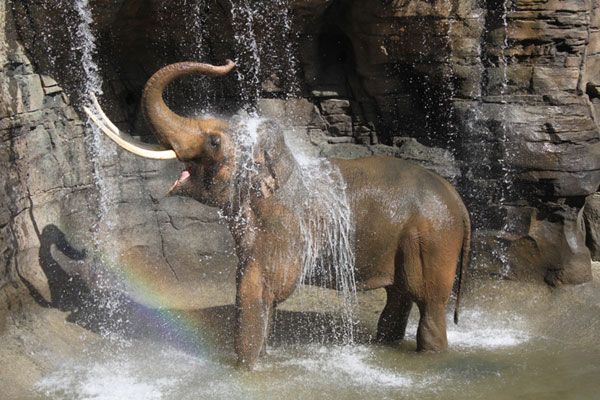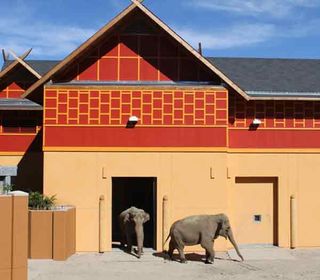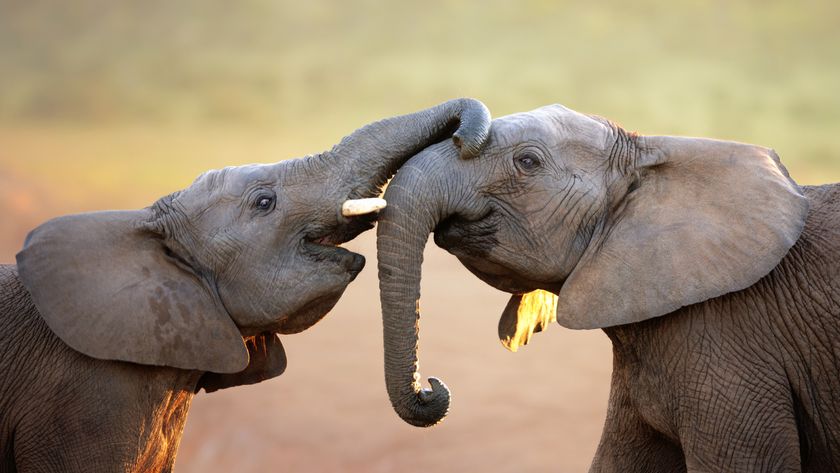
Zoo's New Exhibit Shows Plight of Asian Elephant

The Los Angeles Zoo opens its new Elephants of Asia exhibit today (Dec. 16), giving guests a glimpse of the challenges these majestic beasts face in the wild and their importance to many Asian cultures.
The Asian elephant has been worshipped for centuries in Asian cultures and to this day is used for ceremonial and religious purposes. Asian elephants have been domesticated and used for logging, in wars and as part of religious festivals. In many countries they are also featured in art and architecture. It is also a key biological species in the forests of Asia.
Yet currently there are only 25,600 to 32,750 Asian elephants in isolated populations left.
"Elephants have faced a lot of challenges in the wild, this exhibit teaches the public about the challenges they face in four distinct areas in which Asian elephants can be found," said Jason Jacobs, the Los Angeles Zoo's director of marketing and public relations.
The habitat will be home to three adult elephants, Billy, Tina and Jewel. Eventually, the zoo hopes to expand their numbers.
The different areas of the habitat, which cover the countries where the Asian elephant is found China, Thailand, Cambodia and India raise awareness about the various issues facing the Asian elephant populations in each country.
"Exhibits like this are great at raising awareness about the plight that elephants face and that makes a huge difference when it comes to conservation efforts ," said Barney Long, a species program manager with the conservation group WWF. "Forty to 50 years ago zoos just had animals in cages without any information about conservation, and having that information has made a difference."
Sign up for the Live Science daily newsletter now
Get the world’s most fascinating discoveries delivered straight to your inbox.
Forest Loss and Habitat Fragmentation
Habitat is one particularly deteriorating issue facing Asia's elephants.
"Elephants have very large habitats and Asia has the fastest growing economies, so habitat is being lost at a very fast rate. Areas of their habitat are being turned into acacia, oil palm and tea plantations," Long told OurAmazingPlanet.
Elephants cover huge areas of land every day and their range and distribution is quickly being shrunk by human infrastructure. According to the WWF, about 20 per cent of the world's human population lives in or near the present range of the Asian elephant.
India currently has 20 percent forest cover and in Thailand lowland forest is being cleared to accommodate millions of people resettled from crowded metropolitan regions. In China, habitat loss has reduced the elephant population to less than 250 restricted to southern Yunnan Province.
The changing distribution of the population of Asia has also resulted in fragmentation of elephant habitat. Herds are being broken up as they struggle to navigate a region's changes, which can cause long-term, potentially detrimental genetic changes within Asian elephant populations.

Human-Elephant Conflict
Most of the regions where the forest is destroyed later become farmland. This farmland then cuts off Asian elephants' established routes to seasonal food and water sources and the elephants turn to the crops as their food source.
"One night of eating for elephants can wipe out a farmer's entire crop, which causes economic harm to the farmer and also retaliatory harm; elephants are shot at, poisoned and electrocuted," Long said.
According to the WWF, damage from elephants can range from a few thousand dollars to millions of dollars. Every year, 100 humans (some years as many as 300 people) and 40 to 50 elephants are killed during crop raiding in India.
Encounters like these stir up resentment of elephants; people begin to view the creatures as pests. In 2001, more than 60 elephants were poisoned by plantation workers in retaliation in both India and Sumatra.
Poaching for Ivory
While some Asian elephants do not have the tusks that their African cousins do, elephant poaching is still a problem in some areas of Asia. [Related: How are Asian and African elephants different?]
In recent years, poaching has become a problem in both Thailand and Cambodia. Legally, ivory can be traded in Thailand as long as it is domestic, but it is almost impossible to keep track of where the ivory comes from, and much of it is sourced from Cambodia.
"There has been a decrease in poaching due to a loss of tuskers [elephants with tusks] due to fragmentation, which creates smaller populations and leads to inbreeding," Long said. "But the amount of tuskers has been growing again, which is leading to an increase in poaching."
The Los Angeles Zoo created their Elephants of Asia habitat in the hopes that it can help raise the public's awareness of the issues facing them, as well as what actions people can take to prevent destruction of elephant herds.
"We get over a million visitors a year, and with habitats such as this, people get to see animals they never would have seen otherwise," Jacobs said. "We hope that if they have a chance to see them and learn about them, they'll care more and want to make a difference. It all adds up, if everyone just donated a quarter, imagine what a difference that would make."












